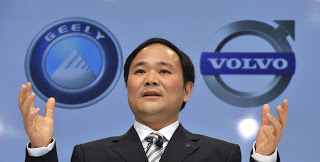How a Chinese Company Saved a Swedish Icon
- Rohan Nidmarti
- Apr 19, 2021
- 3 min read
The year was 1999. Ford Motor Company acquired Volvo for $6.5 billion. Volvo was placed under Ford's premium car division called Premier Automotive Group alongside Jaguar, Land Rover, and Aston Martin (Ford spent $17 billion on these acquisitions). These brands were essentially different car companies with their own intrinsic values and unique markets. There were few synergies that could be achieved by platform-sharing, yet, Ford pushed these brands to share resources in order to cut costs. Volvo engineering resources and components were used in various Ford, Land Rover and Mazda (Ford had a minority stake in Mazda) products. This made some vehicles too similar to mass-market, inexpensive Fords.
The second generation Land Rover Freelander was designed on the same platform as the Volvo S80. The Volvo T5 petrol engine was used in the Ford Focus performance models. While Volvo had been one of the more successful entry-level luxury brands with the Volvo 940 and S70 when it was independent, it soon lost market share to the German trio, who expanded their entry-level offerings. Thus Ford marred the DNA of the Volvo brand which was reputed for its safety and practicality.
In 2009, Volvo was losing money and selling fewer cars than ever. Ford expressed interest to sell the Volvo brand and an obscure Chinese company called Zhejiang Geely, headed by ambitious entrepreneur Li Shufu, emerged as the highest bidder. Volvo was sold for $1.8 billion (a fraction of what Ford paid). Car analysts expressed skepticism over the divestment since Geely was known mostly for building cheap little cars for Chinese consumers buying their first vehicles. To revive Volvo's fortunes, Li Shufu devised a turnaround plan under which he proposed to make Volvo profitable by expanding its sales. Geely built an engine plant and two assembly plants in China, plus another assembly facility in South Carolina, while expanding R&D centres in Sweden and California.
Chinese companies had a poor record in integrating their foreign acquisitions mainly due to cross-cultural management, however, Geely avoided micromanagement and allowed Volvo to function independently. 70% of Volvo's worldwide employees are still in Sweden. Geely's efforts showed signs of success when Volvo recorded a profit of $150 million in 2013. Failed mergers plague the auto industry, however Geely & Volvo has been working. Under Geely's ownership Volvo restructured its lineup. Volvo developed a new line of 3-cylinder & 4-cylinder engines. It developed a new platform, the Scalable Product Architecture (SPA).
Volvo XC90 built under SPA

Geely also placed focus on safety and reliability, two things Volvo was known for. The number one vision that the carmaker has is a pledge to build a deathproof car. Volvo plans to achieve a fatality-free car with safety tech from auto steering to adaptive cruise control. Volvo has always pushed the envelope when it comes to safety. It was the first carmaker to develop seatbelts in in 1959. Volvo also developed pedestrian airbags, knee airbags and Lane Keeping Aid.
Volvo is one of the proponents for autonomous and electric vehicles. Uber announced that it planned to buy 24,000 Volvo cars to develop autonomous technology. Putting a million electric cars on the road by 2025 is another initiative Volvo has. It announced plans to completely stop selling fossil-fuel based cars by 2030. Volvo has also invested $1 billion into Polestar, a new high performance electric brand that is positioned to rival Tesla and Porsche's Taycan. In order to attract millennial customers, Volvo also announced a subscription plan called Care by Volvo.
In 2015, Volvo for the first time sold half a million cars. Last year Volvo sold 710,000 cars. The brand has since moved upmarket, competing against Mercedes-Benz and BMW. China is Volvo's biggest market now. In 2020, Volvo recorded revenues of $31 billion and profits of $2 billion. Geely is now planning to take Volvo public at a valuation of $35 billion. Geely and Volvo's successful marriage is proof that cross-cultural ownership is possible in the auto world. Geely had patience as an investor, it did not take out money but instead reinvested in a new product portfolio. Geely under Li Shufu allowed Volvo to retain its Swedish heritage but brought in its Chinese manufacturing might.




Looks like Rash-drivers must buy a Volvo:)